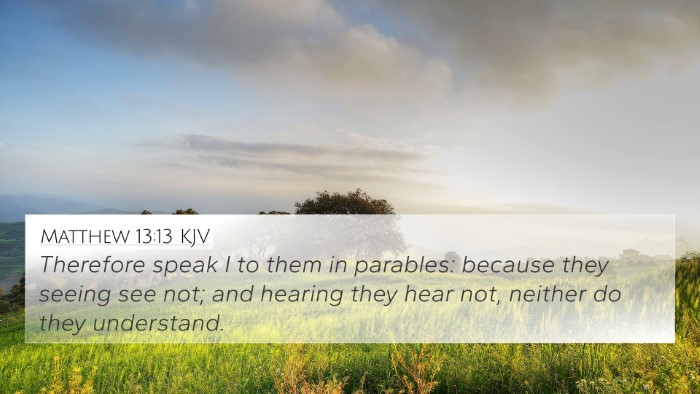Understanding Matthew 13:34
Matthew 13:34 states, "All these things spake Jesus unto the multitude in parables; and without a parable spake he not unto them." This verse emphasizes the teaching method of Jesus, highlighting His use of parables to convey spiritual truths to the people. Below, we explore the significance of this verse by synthesizing insights from various public domain commentaries.
Context of Matthew 13:34
In the broader context of Matthew 13, Jesus is seen teaching the crowds through a series of parables, which serve as illustrative stories designed to reveal deeper spiritual meanings. This method was intended to both disclose truths to those who are receptive and conceal them from those who are hardened in their understanding.
Commentary Insights
-
Matthew Henry:
Henry emphasizes that parables not only illustrate but also encapsulate profound spiritual lessons. He suggests that the choice to teach in parables was strategic, as it would engage the hearts and minds of listeners, inviting them to contemplate their meaning deeply. He argues that this method ensures that only those genuinely seeking truth would grasp the deeper implications.
-
Albert Barnes:
Barnes points out that Jesus’ use of parables represents a fulfillment of prophecy, indicating that He would speak in parables to convey truths. Barnes also suggests that this cryptic form of teaching draws a distinction between those who believe and those who ignore the message, reinforcing the idea that understanding requires a readiness to seek deeper understanding.
-
Adam Clarke:
Clarke notes that the use of parables enables Jesus to reveal and conceal truths simultaneously. He argues that through parables, teachings can be layered, prompting those who are spiritually discerning to seek the underlying messages. Clarke further emphasizes the wisdom in Jesus' approach, as it encourages listeners to engage actively with His teachings.
Bible Verse Cross-References
Several Bible verses relate closely to Matthew 13:34, reinforcing its themes. Here are some notable connections:
- Psalm 78:2 - "I will open my mouth in a parable: I will utter dark sayings of old." This verse underlines the prophetic basis for Jesus’ parabolic teachings.
- Matthew 13:10-11 - "And the disciples came, and said unto him, Why speakest thou unto them in parables? He answered and said unto them, Because it is given unto you to know the mysteries of the kingdom of heaven, but to them it is not given." This directly addresses the rationale behind His choice of teaching.
- Mark 4:11-12 - "And he said unto them, Unto you it is given to know the mystery of the kingdom of God: but unto them that are without, all these things are done in parables." This reaffirms the selective nature of understanding divine truths.
- Luke 8:10 - "And he said, Unto you it is given to know the mysteries of the kingdom of God: but to others in parables; that seeing they might not see, and hearing they might not understand." This highlights the purpose of parables as a means of truth delivery.
- Proverbs 1:6 - "To understand a proverb, and the interpretation; the words of the wise, and their dark sayings." This reflects the wisdom embedded within parables and the discernment required to grasp their messages.
- John 10:6 - "This parable spake Jesus unto them: but they understood not what things they were which he spake unto them." This further exemplifies the challenge and depth of Jesus' parabolic instruction.
- Matthew 7:29 - "For he taught them as one having authority, and not as the scribes." This illustrates the distinctive authority with which Jesus taught, setting Him apart from other teachers of the law.
Thematic Connections
Matthew 13:34 encapsulates several central themes present in the ministry of Jesus:
- The Nature of the Kingdom of God: The parables unveil aspects of the kingdom, emphasizing its mystery and availability of understanding to those who seek it sincerely.
- Spiritual Understanding: A recurrent theme is the contrast between the wise and the foolish, demonstrating that true spiritual insight is a gift given to the earnest seeker.
- Revelation and Concealment: The idea that some truths are hidden from certain audiences aligns with the biblical theme of divine revelation being selectively granted.
Tools for Bible Cross-Referencing
For those interested in further exploring the connections between Bible verses, consider utilizing:
- Bible Concordances: Provide an index of terms and their occurrences, aiding in finding related scriptures.
- Bible Cross-Reference Guides: These compile verses that connect thematically or contextually, supporting deeper studies.
- Cross-Reference Bible Study Methods: Techniques that help readers identify and explore scripture linkages for deeper understanding.
Conclusion
In summary, Matthew 13:34 serves as a critical piece in understanding the teaching methods of Jesus and the nature of His messages through parables. Commentaries by Matthew Henry, Albert Barnes, and Adam Clarke collectively underscore the depth and specificity of Jesus’ parables, urging readers to engage more deeply with scripture. Additionally, the verse connects richly with numerous biblical texts, enhancing the understanding of the interconnected themes found throughout the Bible.





